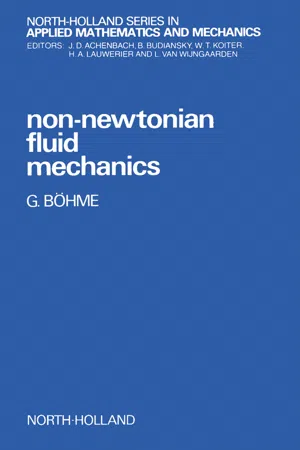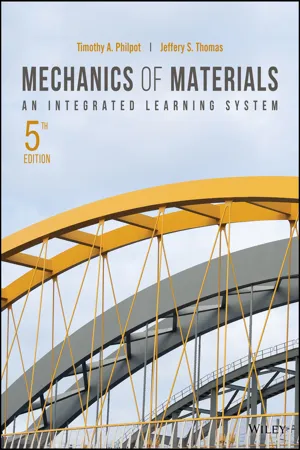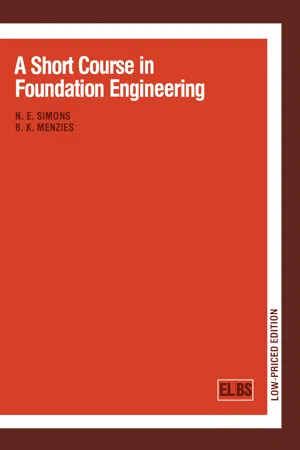Technology & Engineering
Shear Stress in Fluids
Shear stress in fluids refers to the force per unit area that acts parallel to the surface of the fluid. It is a measure of the internal resistance of a fluid to flow when subjected to an external force. Shear stress is an important concept in fluid mechanics and is used to analyze the behavior of fluids in various engineering applications.
Written by Perlego with AI-assistance
Related key terms
1 of 5
10 Key excerpts on "Shear Stress in Fluids"
- Robert W. Fox, Alan T. McDonald, John W. Mitchell(Authors)
- 2020(Publication Date)
- Wiley(Publisher)
2.4 Viscosity Where do stresses come from? For a solid, stresses develop when the material is elastically deformed or strained; for a fluid, shear stresses arise due to viscous flow. Hence we say solids are elastic, and fluids are viscous. For a fluid at rest, there will be no shear stresses. We will see that each fluid can be categorized by examining the relation between the applied shear stresses and the flow of the fluid. Consider the behavior of a fluid element between the two infinite plates shown in Fig. 2.9a. The rectangular fluid element is initially at rest at time t . Let us now suppose a constant rightward force δF x is applied to the upper plate so that it is dragged across the fluid at constant velocity δu. The relative shearing action of the infinite plates produces a shear stress, τ yx , which acts on the fluid element and is given by τ yx = lim δA y 0 δF x δA y = dF x dA y σ yy τ yx τ yz τ zy τ zx σ zz τ xy σ xx τ xz σ yy τ yx τ yz x z y τ zy τ zx σ zz τ xy σ xx τ xz Fig. 2.8 Notation for stress. (a) (b) (c) δ x δ α δ y x y N O N O N O δl δF δ u δ F δ u M M M' P P P' δl 2 M M' M'' P P' P'' Fig. 2.9 (a) Fluid element at time t, (b) deformation of fluid element at time t + δt, and (c) deformation of fluid element at time t + 2δt. 25 2.4 Viscosity where δA y is the area of contact of the fluid element with the plate and δF x is the force exerted by the plate on that element. Snapshots of the fluid element, shown in Figs. 2.9a–c, illustrate the deformation of the fluid element from position MNOP at time t , to M NOP at time t + 2δt , to M NOP at time t + 2δt , due to the imposed shear stress. It is the fact that a fluid continually deforms in response to an applied shear stress that sets it apart from solids. Focusing on the time interval δt (Fig. 2.9b), the deformation of the fluid is given by deformation rate = lim δt 0 δα δt = dα dt We want to express dα dt in terms of readily measurable quantities.- eBook - PDF
- Theunis Christoffel Robberts(Author)
- 2013(Publication Date)
- CRC Press(Publisher)
It follows that water is about 100 times more compressible than steel. 4.1.6 Ideal Fluid An ideal or perfect fluid is one in which there are no tangential or shear stresses between the fluid particles. The forces always act normally at a section and are limited to pressure and acceleration forces. No real fluid fully complies with this concept, and for all fluids in motion there are tangential stresses present that have a dampening effect on the motion. However, some liquids, including water, are near to an ideal fluid, and this simplified assumption enables mathematical or graphical methods to be adopted in the solution of certain flow problems. 4.1.7 Viscosity Fluids are substances that undergo continuous deformation when shear stress is applied. Viscosity * of a fluid is a measure of its resistance to tangential or shear stress. It arises from the interaction and cohesion of fluid molecules. All real fluids possess viscosity, though to varying degrees. The shear stress in a solid is propor-tional to strain, whereas the shear stress in a fluid is proportional to the rate of shearing strain. It follows that there can be no shear stress in a fluid that is at rest. Consider a fluid confined between two plates that are situated a very short distance δ y apart. The lower plate is stationary while the upper plate is moving at velocity v. The fluid motion is assumed to take place in a series of infinitely thin lay-ers or laminae, free to slide one over the other. There is no cross flow or turbulence (see Figure 4.1). The layer adjacent to the stationary plate is at rest while the layer adjacent to the moving plate has a velocity v. The rate of shearing strain or velocity gradient γ = dv/ dy. The dynamic viscosity or, more simply, the viscosity μ is given by * Viscosity describes a liquid’s resistance to flow. High viscosity means a liquid with flow proper-ties that are near to those of a solid (i.e., glass). - eBook - PDF
- G. Böhme(Author)
- 2012(Publication Date)
- North Holland(Publisher)
Because in a shear flow the strain rate tensor has only one important parameter, namely the shear rate y, the law of friction of a Newtonian fluid in this case reduces to a scalar statement T = 11 i (2.1) according to which the shear stress T between the layers increases lin-early with y. The (always posi ti ve) coefficient of proportionali ty n is called the shear viscosity, or briefly viscosity, and it is a char-acteristic material quantity for the fluid concerned, which in general depends on temperature and pressure, but not on the amount of the rate of shear. Understanding of the following reasoning will be easier if we for the moment examine an unsteady shear flow. For the sake of simplicity consider a motion which has the velocity field v = u(y,t)e x ' for which 46 2 Material properties occurring in steady shear flows each plane layer y = constant rnoves with a tirne dependent velocity u(y,t) in the x-direction (Fig. 2.1). Jt Fig. 2.1 Unsteady plane shear flow Such a flow occurs for example in a viscous flow in a channel between two parallel plates when these are rnoved wi th different veloci ties in a tangential direction. It is clear that under these conditions the shear rate, y:= dU/ay, and the shear stress depend on position and tirne. We shall therefore write equation (2.l) in more detail in the form T (y, t) = '1 i (y. t) (2.2) This relationship, valid for Newtonian fluids, is very simple from three aspects. It states firstly that the shear stress acting at the actual time on an arbi trarily chosen fluid particle depends only on the momentary state of motion of the particle. Its motion at other times does not affect the shear stress occurring at the time (instantaneous reaction). It states secondly that the shear stress at a certain point depends only on the shear rate and therefore on the veloci ty gradient at this point. - Allan D. Kraus, James R. Welty, Abdul Aziz(Authors)
- 2011(Publication Date)
- CRC Press(Publisher)
A piece of the boundary of a general fluid element is shown in Figure 11.9. We note that a small portion of the surface, S , has a surface force, F acting on it. The vector, n , is the outwardly directed unit vector normal to S . The force, F , can thus be resolved into its normal and tangential components, F n and F t , as indicated. We then define the normal and shear stresses at S , consistent with continuum behavior as = lim S −→ 0 F n S (11.13) and = lim S −→ 0 F t S (11.14) respectively. These stress components, and , will have varying character depending on the orientation of the surface, S , used in their definitions. Stress is, in general, a tensor quantity of second order: this means that its complete specification involves nine components. This is in contrast to a vector quantity (a first-order tensor) having three components and a scalar (a zeroth-order tensor), which has only one. In Figure 11.10, we show two elements in a fluid continuum. The configuration of the element in Figure 11.10a is consistent with Cartesian or rectangular coordinates; its di-mensions are x, y , and z in the directions corresponding to the coordinate directions. Δ S Δ F t Δ F n ΔF n FIGURE 11.9 A surface force acting on an element of surface S . 338 Introduction to Thermal and Fluid Engineering σ yy σ xx σ zz τ yx τ zx τ xz Δ x Δ y Δ z τ zy τ xy x z y τ yz (a) σ zz τ zr τ z θ τ θ r σ rr τ r θ τ rz z θ (b) r Δ z σ θθ r Δθ Δ r τ θ z FIGURE 11.10 Stress in fluid elements: (a) rectangular coordinates and (b) cylindrical coordinates. In Figure 11.10b, we show an element consistent with a cylindrical coordinate system where we note that its sides have lengths r, r , and z . On each face, the stress can be resolved into three components as shown. By conventions, shear stresses, parallel to the face, are labeled and normal stresses, perpendicular to the face, are labeled .- eBook - PDF
- M J Iremonger(Author)
- 2013(Publication Date)
- Butterworth-Heinemann(Publisher)
Chapter 4 Shear and torsion ESSENTIAL THEORY 4.1 Shear stress Shear stress is the stress component parallel to the plane on which it acts. With the notation shown in Figure 4.1 the shear stress is defined as r = Q/A (4.1) where τ represents the actual (uniform) stress if the force Q is uniformly distributed over the area A and the average stress if Q is not uniformly distributed. In the latter case the actual shear stress at any point can be defined by the limiting ratio of SQ/8A where 5^4 represents the area of a small element of material over which the stress can reasonably be assumed to be uniform. Figure 4.1 Figure 4.2 In order to preserve equilibrium every shear stress (r) is accompanied by an equal complementary shear stress on a plane at right angles as shown in Figure 4.2. 33 34 Shear and torsion 4.2 Shear strain Shear strain (7) is a dimensionless measure of the distortion of a rectangular element under shear. For small strains 7 = tan0 ^ 0 (4.2) where φ is the angle shown in Figure 4.2 measured in radians. 4.3 Stress-strain relations The shear stress—shear strain relationships are qualitatively similar to the direct stress—direct strain relationships described in Section 3.2. In the linear elastic region where Hooke's Law is obeyed, the gradient of the shear stress—strain curve is a constant called shear modulus (G, modulus of rigidity) where G = τ/γ (4.3) 4.4 Relationship between elastic constants When the material behaviour is linearly elastic and isotropic (properties independent of direction) there are only two independent elastic constants. The shear modulus (G) is related to Young's modulus (E) and Poisson's ratio (y) by the equation E = 2G(l + 1/) (4.4) If any two of the constants are known the third can be found from this equation. A fourth, less commonly used, elastic constant is bulk modulus. This represents a volumetric stress divided by volumetric strain. - eBook - PDF
Mechanics of Materials
An Integrated Learning System
- Timothy A. Philpot, Jeffery S. Thomas(Authors)
- 2020(Publication Date)
- Wiley(Publisher)
For instance, if the shear force acts downward on the beam section of Figure 9.22a, then we can recognize immediately that the shear flow in the web must act downward as well. Also, since the shear flow must be continuous through the section, we can infer that (a) the shear flows in the upper flange must move toward the web and (b) the shear flows in the bottom flange must move away from the web. Using this simple technique to ascertain the directions of shear flows and shear stresses is easier than visualizing the directions of the forces acting on elements such as those in Figures 9.16b and 9.17b. The preceding analysis demonstrates how shear stresses and shear flow in a thin-walled cross section can be calculated. The results offer a more complete understanding of how shear stresses are distributed throughout a beam that is subjected to shear forces. (Recall that, in Section 9.7, shear stresses in a wide- flange cross section were determined for the web only.) Three important conclu- sions should be drawn from this analysis: 1. The shear flow q is dependent on the value of Q, and Q will vary throughout the cross section. For beam cross-sectional elements that are perpendicular to the direction of the shear force V, q and hence will vary linearly in magni- tude. Both q and will vary parabolically in cross-sectional elements that are parallel to or inclined toward the direction of V. 2. Shear flow will always act parallel to the free surfaces of the cross-sectional elements. 3. Shear flow is always continuous in any cross-sectional shape subjected to a shear force. Visualization of this flow pattern can be used to establish the di- rection of both q and in a shape. The flow is such that the shear flows in the various cross-sectional elements contribute to V while satisfying both horizon- tal and vertical equilibrium. - eBook - PDF
Physics of Continuous Matter
Exotic and Everyday Phenomena in the Macroscopic World
- B. Lautrup(Author)
- 2011(Publication Date)
- CRC Press(Publisher)
The component acting tangentially to the surface is called a shear force or a traction force . Fluids in motion, and solids at rest or in motion, are able to sustain shear forces, whereas fluids at rest cannot. Should shear forces arise in a fluid at rest, it will begin to flow until it again reaches mechanical equilibrium without shear forces. In this chapter we shall first investigate the basic properties of pressure, and afterward develop the mathematical formalism that permits us to analyze hydrostatic equilibrium in the sea and the atmosphere. Along the way we shall recapitulate some basic rules of thermody-namics. In the following chapters we shall continue to study the implications of hydrostatic equilibrium for balloons and ships, and the shapes of large fluid bodies subject only to gravity and small fluid bodies subject mainly to surface tension. 2.1 What is pressure? Pressure is defined as normal force per unit of area . The SI–unit for pressure is accordingly newton per square meter, but was in 1971 given the name pascal and the special symbol Pa D N m 2 . Earlier units for pressure were the bar ( 1 bar D 10 5 Pa) and the standard atmosphere ( 1 atm D 101; 325 Pa), which is close to the average air pressure at sea level. Modern television weather forecasters are now abandoning the older units and tend to quote air pressure in hectopascals rather than in millibars, even if they are exactly the same ( 1 hPa D 100 Pa D 10 3 bar D 1 millibar). 22 PHYSICS OF CONTINUOUS MATTER Case: The incompressible sea A p 0 p h 6 pA ? p 0 A r ? Mg 0 A column of sea water. The pres-sure difference between bottom and top must carry the weight of the water in the box. Notice that the sum of the forces vanishes. Before presenting a formal definition of the pressure field, we use simple arguments to cal-culate it in the sea. In the first approximation, water is incompressible and has everywhere the same mass density 0 . - eBook - PDF
- N. E. Simons, B. K. Menzies(Authors)
- 2016(Publication Date)
- Butterworth-Heinemann(Publisher)
2 Shear strength 1 The definition of shear strength The shear strength of a soil in any direction is the maximum shear stress that can be applied to the soil structure in that direction. When this maximum has been reached, the soil is regarded as having failed, the strength of the soil having been fully mobilized. 2 The nature of shear strength When soil fails it does so by means of some plastic failure mechanism involving shear. The shear strength of a soil is derived from the structural strength alone, the pore-water having no shear strength. The resistance of the soil structure to shear arises from the frictional resistance, F, generated by the interparticle forces, 7V(Fig.2.1). In the soil mass, the loading transmitted by the soil structure normally to the shear surface is an integrated measure of these interparticle forces. Thus, the shear strength, 7y(shear stress at failure), on any plane in a soil, is some func-tion of the effective stress normal to that plane. Assuming a linear relationship gives T f =k l + k 2 (o n -u) (2.1) where o n is the total stress normal to the plane, u is the pore-water pressure, and k± and k 2 are two experimentally determined constants. Experiment has shown this expression to be substantially correct over a wide range of soils for a limited range of stresses. Soil particle Interparticle force normal to shear surface' Shear surface Relative displacement of soil in the mass Fig. 2.1 Forces arising at in ter-particle slip Load platen ^(applied normal load) Induced x/v// shear surface V///A y^ —^P(shear force) Soil specimen Fig. 2.2 A schematic section through the direct shear box Common usage has k x = c k 2 = tan0' whence Tf= c + (o n -u) tan (j) (2.2) (2.3) (2.4) where c is the cohesion intercept and 0' is the angle of shearing resistance, with respect to effec-tive stress. - eBook - PDF
- N.E. Simons, B.K. Menzies(Authors)
- 2013(Publication Date)
- Butterworth-Heinemann(Publisher)
2 Shear strength 1 The definition of shear strength The shear strength of a soil in any direction is the maximum shear stress that can be applied to the soil structure in that direction. When this maximum has been reached, the soil is regarded as having failed, the strength of the soil having been fully mobilized. 2 The nature of shear strength When soil fails it does so by means of some plastic failure mechanism involving shear. The shear strength of a soil is derived from the structural strength alone, the pore-water having no shear strength. The resistance of the soil structure to shear arises from the frictional resistance, F, generated by the interparticle forces, 7V(Fig.2.1). In the soil mass, the loading transmitted by the soil structure normally to the shear surface is an integrated measure of these interparticle forces. Thus, the shear strength, 7y(shear stress at failure), on any plane in a soil, is some func-tion of the effective stress normal to that plane. Assuming a linear relationship gives r f =k 1 + k 2 (a n -u) (2.1) where o n is the total stress normal to the plane, u is the pore-water pressure, and k^ and k 2 are two experimentally determined constants. Experiment has shown this expression to be substantially correct over a wide range of soils for a limited range of stresses. Soil particle Interparticle force normal to shear surface' Shear surface Relative displacement of soil in the mass Fig. 2.1 Forces arising at inter-particle slip //(applied normal load) Load platen v ι , . . -/ λ .·.: i --.■.<■..., r / 1 -P(shear force) Induced Υ///Λ shear surface V///A Soil specimen Fig.2.2 A schematic section through the direct shear box Common usage has *! = c (2.2) fc 2 = tan0' (2.3) whence Tf= c + (σ η -u) tan φ' (2.4) where c is the cohesion intercept and φ' is the angle of shearing resistance, with respect to effec-tive stress. - eBook - PDF
- J. A. Blom(Author)
- 2003(Publication Date)
- CRC Press(Publisher)
Laminar flow in free space has parallel flow lines with equal velocities (a). Velo-cities are zero at a wall (b). At high flows, flow lines are not parallel anymore but show tur-bulence (c). Pressure is created due to the (nearly) elastic collisions of the molecules of the fluid with the surface of a body (e.g., a pressure transducer). When a fluid is viscous , there is friction (momentum transfer) between the flow lines or flow layers in the fluid. Fluid viscosity produces shearing forces (or simply shear ). Shear stress is the frictional force between neighboring flow layers or between a flow layer and the vessel wall. The difference between a solid and a fluid is that a fluid does not resist being “sheared”: whereas it is hard to compress a solid 45 46 Monitoring of Respiration and Circulation by a unidirectional force, a fluid just moves away. Fluids do, however, resist variations in the rate of change of shear: they are viscous; that is, one fluid layer tends to take neighboring layers along in its flow. Greater resistance to variation in shear rate of change means higher viscosity: in that case the fluid is more “sirupy.” In a laminar flow, viscosity ensures that neighboring flow lines have near identical velocities (see Figure 2.1b). Sometimes the region of high shear is confined to a thin layer of fluid (the “boundary layer”) near the wall of the vessel through which it flows. If that is the case, then outside this layer the fluid behaves as if it were inviscid. Even if the fluid is viscous, the assumption of zero viscosity will be acceptable if the boundary layer is thin compared to the radius of the vessel. The derivation of the equations of motion for fluid particles originates from a number of conservation laws: mass, momentum (or impulse) and energy in a certain volume are equal to the rate at which they enter that volume plus the rate at which they are created (or destroyed) inside that volume minus the rate at which they leave that volume.
Index pages curate the most relevant extracts from our library of academic textbooks. They’ve been created using an in-house natural language model (NLM), each adding context and meaning to key research topics.









